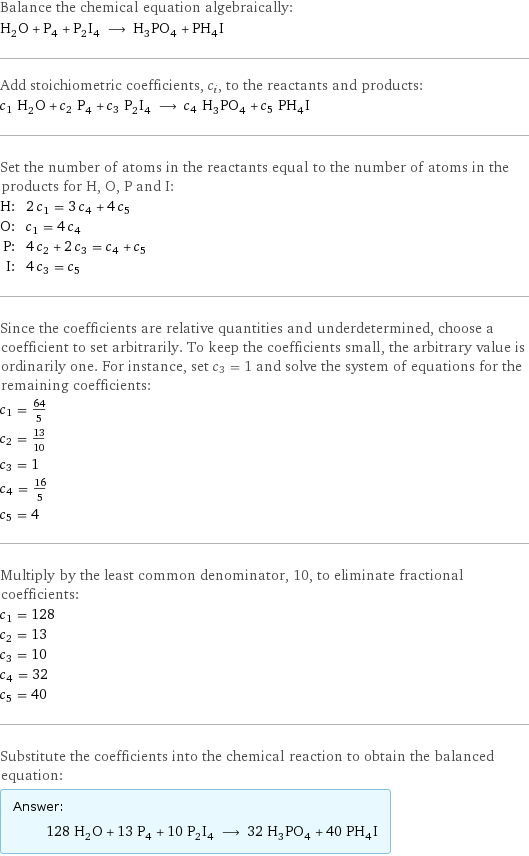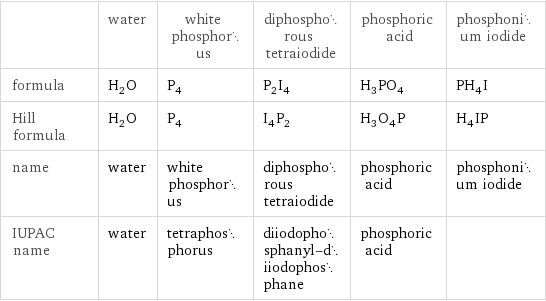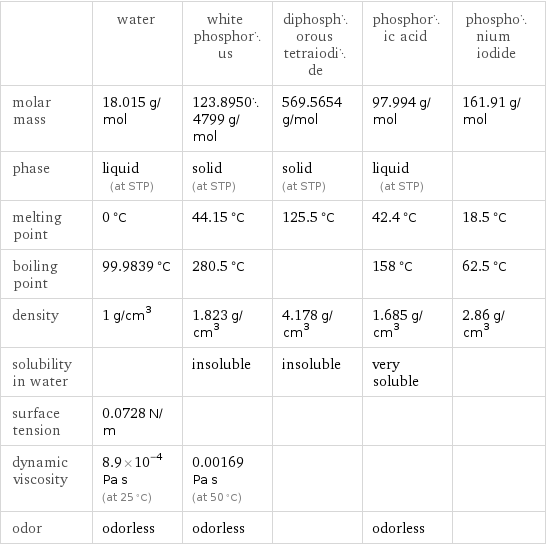Input interpretation

H_2O (water) + P_4 (white phosphorus) + P_2I_4 (diphosphorous tetraiodide) ⟶ H_3PO_4 (phosphoric acid) + PH_4I (phosphonium iodide)
Balanced equation

Balance the chemical equation algebraically: H_2O + P_4 + P_2I_4 ⟶ H_3PO_4 + PH_4I Add stoichiometric coefficients, c_i, to the reactants and products: c_1 H_2O + c_2 P_4 + c_3 P_2I_4 ⟶ c_4 H_3PO_4 + c_5 PH_4I Set the number of atoms in the reactants equal to the number of atoms in the products for H, O, P and I: H: | 2 c_1 = 3 c_4 + 4 c_5 O: | c_1 = 4 c_4 P: | 4 c_2 + 2 c_3 = c_4 + c_5 I: | 4 c_3 = c_5 Since the coefficients are relative quantities and underdetermined, choose a coefficient to set arbitrarily. To keep the coefficients small, the arbitrary value is ordinarily one. For instance, set c_3 = 1 and solve the system of equations for the remaining coefficients: c_1 = 64/5 c_2 = 13/10 c_3 = 1 c_4 = 16/5 c_5 = 4 Multiply by the least common denominator, 10, to eliminate fractional coefficients: c_1 = 128 c_2 = 13 c_3 = 10 c_4 = 32 c_5 = 40 Substitute the coefficients into the chemical reaction to obtain the balanced equation: Answer: | | 128 H_2O + 13 P_4 + 10 P_2I_4 ⟶ 32 H_3PO_4 + 40 PH_4I
Structures

+ + ⟶ +
Names

water + white phosphorus + diphosphorous tetraiodide ⟶ phosphoric acid + phosphonium iodide
Equilibrium constant
![Construct the equilibrium constant, K, expression for: H_2O + P_4 + P_2I_4 ⟶ H_3PO_4 + PH_4I Plan: • Balance the chemical equation. • Determine the stoichiometric numbers. • Assemble the activity expression for each chemical species. • Use the activity expressions to build the equilibrium constant expression. Write the balanced chemical equation: 128 H_2O + 13 P_4 + 10 P_2I_4 ⟶ 32 H_3PO_4 + 40 PH_4I Assign stoichiometric numbers, ν_i, using the stoichiometric coefficients, c_i, from the balanced chemical equation in the following manner: ν_i = -c_i for reactants and ν_i = c_i for products: chemical species | c_i | ν_i H_2O | 128 | -128 P_4 | 13 | -13 P_2I_4 | 10 | -10 H_3PO_4 | 32 | 32 PH_4I | 40 | 40 Assemble the activity expressions accounting for the state of matter and ν_i: chemical species | c_i | ν_i | activity expression H_2O | 128 | -128 | ([H2O])^(-128) P_4 | 13 | -13 | ([P4])^(-13) P_2I_4 | 10 | -10 | ([P2I4])^(-10) H_3PO_4 | 32 | 32 | ([H3PO4])^32 PH_4I | 40 | 40 | ([PH4I])^40 The equilibrium constant symbol in the concentration basis is: K_c Mulitply the activity expressions to arrive at the K_c expression: Answer: | | K_c = ([H2O])^(-128) ([P4])^(-13) ([P2I4])^(-10) ([H3PO4])^32 ([PH4I])^40 = (([H3PO4])^32 ([PH4I])^40)/(([H2O])^128 ([P4])^13 ([P2I4])^10)](../image_source/4dba3239ca241ed12622beabada4854d.png)
Construct the equilibrium constant, K, expression for: H_2O + P_4 + P_2I_4 ⟶ H_3PO_4 + PH_4I Plan: • Balance the chemical equation. • Determine the stoichiometric numbers. • Assemble the activity expression for each chemical species. • Use the activity expressions to build the equilibrium constant expression. Write the balanced chemical equation: 128 H_2O + 13 P_4 + 10 P_2I_4 ⟶ 32 H_3PO_4 + 40 PH_4I Assign stoichiometric numbers, ν_i, using the stoichiometric coefficients, c_i, from the balanced chemical equation in the following manner: ν_i = -c_i for reactants and ν_i = c_i for products: chemical species | c_i | ν_i H_2O | 128 | -128 P_4 | 13 | -13 P_2I_4 | 10 | -10 H_3PO_4 | 32 | 32 PH_4I | 40 | 40 Assemble the activity expressions accounting for the state of matter and ν_i: chemical species | c_i | ν_i | activity expression H_2O | 128 | -128 | ([H2O])^(-128) P_4 | 13 | -13 | ([P4])^(-13) P_2I_4 | 10 | -10 | ([P2I4])^(-10) H_3PO_4 | 32 | 32 | ([H3PO4])^32 PH_4I | 40 | 40 | ([PH4I])^40 The equilibrium constant symbol in the concentration basis is: K_c Mulitply the activity expressions to arrive at the K_c expression: Answer: | | K_c = ([H2O])^(-128) ([P4])^(-13) ([P2I4])^(-10) ([H3PO4])^32 ([PH4I])^40 = (([H3PO4])^32 ([PH4I])^40)/(([H2O])^128 ([P4])^13 ([P2I4])^10)
Rate of reaction
![Construct the rate of reaction expression for: H_2O + P_4 + P_2I_4 ⟶ H_3PO_4 + PH_4I Plan: • Balance the chemical equation. • Determine the stoichiometric numbers. • Assemble the rate term for each chemical species. • Write the rate of reaction expression. Write the balanced chemical equation: 128 H_2O + 13 P_4 + 10 P_2I_4 ⟶ 32 H_3PO_4 + 40 PH_4I Assign stoichiometric numbers, ν_i, using the stoichiometric coefficients, c_i, from the balanced chemical equation in the following manner: ν_i = -c_i for reactants and ν_i = c_i for products: chemical species | c_i | ν_i H_2O | 128 | -128 P_4 | 13 | -13 P_2I_4 | 10 | -10 H_3PO_4 | 32 | 32 PH_4I | 40 | 40 The rate term for each chemical species, B_i, is 1/ν_i(Δ[B_i])/(Δt) where [B_i] is the amount concentration and t is time: chemical species | c_i | ν_i | rate term H_2O | 128 | -128 | -1/128 (Δ[H2O])/(Δt) P_4 | 13 | -13 | -1/13 (Δ[P4])/(Δt) P_2I_4 | 10 | -10 | -1/10 (Δ[P2I4])/(Δt) H_3PO_4 | 32 | 32 | 1/32 (Δ[H3PO4])/(Δt) PH_4I | 40 | 40 | 1/40 (Δ[PH4I])/(Δt) (for infinitesimal rate of change, replace Δ with d) Set the rate terms equal to each other to arrive at the rate expression: Answer: | | rate = -1/128 (Δ[H2O])/(Δt) = -1/13 (Δ[P4])/(Δt) = -1/10 (Δ[P2I4])/(Δt) = 1/32 (Δ[H3PO4])/(Δt) = 1/40 (Δ[PH4I])/(Δt) (assuming constant volume and no accumulation of intermediates or side products)](../image_source/e57a6774a90a262083fd70fe2aa95f3e.png)
Construct the rate of reaction expression for: H_2O + P_4 + P_2I_4 ⟶ H_3PO_4 + PH_4I Plan: • Balance the chemical equation. • Determine the stoichiometric numbers. • Assemble the rate term for each chemical species. • Write the rate of reaction expression. Write the balanced chemical equation: 128 H_2O + 13 P_4 + 10 P_2I_4 ⟶ 32 H_3PO_4 + 40 PH_4I Assign stoichiometric numbers, ν_i, using the stoichiometric coefficients, c_i, from the balanced chemical equation in the following manner: ν_i = -c_i for reactants and ν_i = c_i for products: chemical species | c_i | ν_i H_2O | 128 | -128 P_4 | 13 | -13 P_2I_4 | 10 | -10 H_3PO_4 | 32 | 32 PH_4I | 40 | 40 The rate term for each chemical species, B_i, is 1/ν_i(Δ[B_i])/(Δt) where [B_i] is the amount concentration and t is time: chemical species | c_i | ν_i | rate term H_2O | 128 | -128 | -1/128 (Δ[H2O])/(Δt) P_4 | 13 | -13 | -1/13 (Δ[P4])/(Δt) P_2I_4 | 10 | -10 | -1/10 (Δ[P2I4])/(Δt) H_3PO_4 | 32 | 32 | 1/32 (Δ[H3PO4])/(Δt) PH_4I | 40 | 40 | 1/40 (Δ[PH4I])/(Δt) (for infinitesimal rate of change, replace Δ with d) Set the rate terms equal to each other to arrive at the rate expression: Answer: | | rate = -1/128 (Δ[H2O])/(Δt) = -1/13 (Δ[P4])/(Δt) = -1/10 (Δ[P2I4])/(Δt) = 1/32 (Δ[H3PO4])/(Δt) = 1/40 (Δ[PH4I])/(Δt) (assuming constant volume and no accumulation of intermediates or side products)
Chemical names and formulas

| water | white phosphorus | diphosphorous tetraiodide | phosphoric acid | phosphonium iodide formula | H_2O | P_4 | P_2I_4 | H_3PO_4 | PH_4I Hill formula | H_2O | P_4 | I_4P_2 | H_3O_4P | H_4IP name | water | white phosphorus | diphosphorous tetraiodide | phosphoric acid | phosphonium iodide IUPAC name | water | tetraphosphorus | diiodophosphanyl-diiodophosphane | phosphoric acid |
Substance properties

| water | white phosphorus | diphosphorous tetraiodide | phosphoric acid | phosphonium iodide molar mass | 18.015 g/mol | 123.89504799 g/mol | 569.5654 g/mol | 97.994 g/mol | 161.91 g/mol phase | liquid (at STP) | solid (at STP) | solid (at STP) | liquid (at STP) | melting point | 0 °C | 44.15 °C | 125.5 °C | 42.4 °C | 18.5 °C boiling point | 99.9839 °C | 280.5 °C | | 158 °C | 62.5 °C density | 1 g/cm^3 | 1.823 g/cm^3 | 4.178 g/cm^3 | 1.685 g/cm^3 | 2.86 g/cm^3 solubility in water | | insoluble | insoluble | very soluble | surface tension | 0.0728 N/m | | | | dynamic viscosity | 8.9×10^-4 Pa s (at 25 °C) | 0.00169 Pa s (at 50 °C) | | | odor | odorless | odorless | | odorless |
Units
